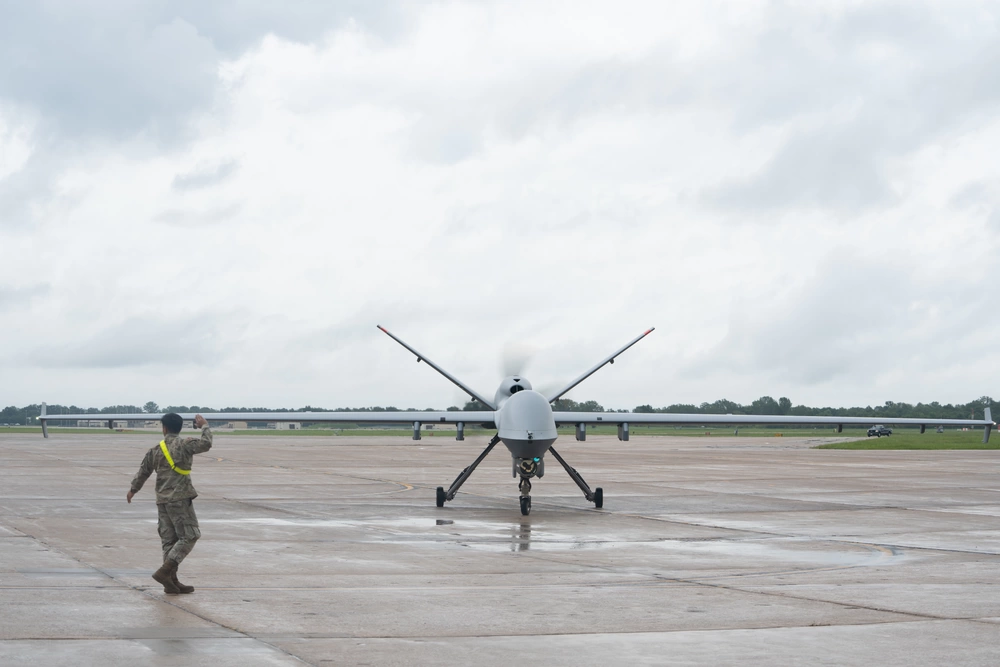A $13 million US Air Force MQ-9 Reaper drone crashed into the Mediterranean Sea last December when the aircraft's propeller became disconnected and fell off in mid-air, an accident investigation has found.
The MQ-9, assigned to the 432nd Fighter Wing at Creech Air Force Base in Nevada, likely suffered a critical failure of a seal holding the propeller in place mid-flight, leading to the loss of the propeller in the Dec. 16 crash.

An MQ-9 Reaper at Whiteman Air Force Base in Missouri. Photo US DOD
The Reaper, remotely piloted by a pilot and sensor operator from the 20th Attack Squadron at Whiteman Air Force Base in Missouri, took off from an unknown location in the European Command area of responsibility, according to a report released by the crash investigation board.
At approximately 5:00 p.m. Greenwich time on December 16, 2024, the Reaper was flying at cruise speed and altitude when engine torque suddenly dropped, losing all torque in a matter of seconds. Engine speed soared beyond normal operating range, and warning messages began to flash.
The pilot throttled the Reaper to full power, but the engine torque remained unchanged. The Reaper maintained altitude for a while until it began to lose speed and dive.
The crew began taking steps to try to maintain control of the landing Reaper and declared an emergency. The pilot turned the Reaper toward the airport it had taken off from and identified a remote, uninhabited area where it could land safely, if necessary.
About 15 minutes later, Reaper detected metal debris in the engine oil. The crew decided not to restart the engine because of the metal debris. The engine then shut down completely.

The MQ-9 Reaper uses a three-bladed engine, one of which is said to have suddenly fallen off, causing the $13 million UAV to crash into the sea. Photo: Topwar
The drone continued to lose altitude, and the operations manager on duty ordered the crew to crash it into the water, which it did at 5:23 p.m. The MQ-9 Reaper was lost in the Mediterranean and has not been recovered, leaving investigators unable to analyze the hardware to determine exactly what happened.
General Atomics, the maker of the Reaper drone, analyzed the data logs of the crashed aircraft and concluded that it lost torque when the propeller “separated” from the engine. The report said the Reaper’s two systems began recording different speeds, which would only happen if the propellers were disconnected.
The report’s authors wrote that General Atomics said the most likely cause was a failure of a twist-lock ring inside the gearbox. General Atomics declined to comment when contacted by Defense News.
Honeywell, the MQ-9's engine manufacturer, has begun replacing these rings every 3,000 flight hours in recent years to try to reduce these failures.
However, the Reaper that crashed in December was only halfway through its next overhaul and seal replacement, meaning the seals were wearing out sooner than expected.
Source: https://khoahocdoisong.vn/hy-huu-uav-13-trieu-do-lao-xuong-bien-vi-bong-dung-roi-mat-canh-quat-post2149046020.html



































































![[Photo] Party and State leaders visit President Ho Chi Minh's Mausoleum and offer incense to commemorate Heroes and Martyrs](https://vphoto.vietnam.vn/thumb/402x226/vietnam/resource/IMAGE/2025/8/17/ca4f4b61522f4945b3715b12ee1ac46c)






























Comment (0)